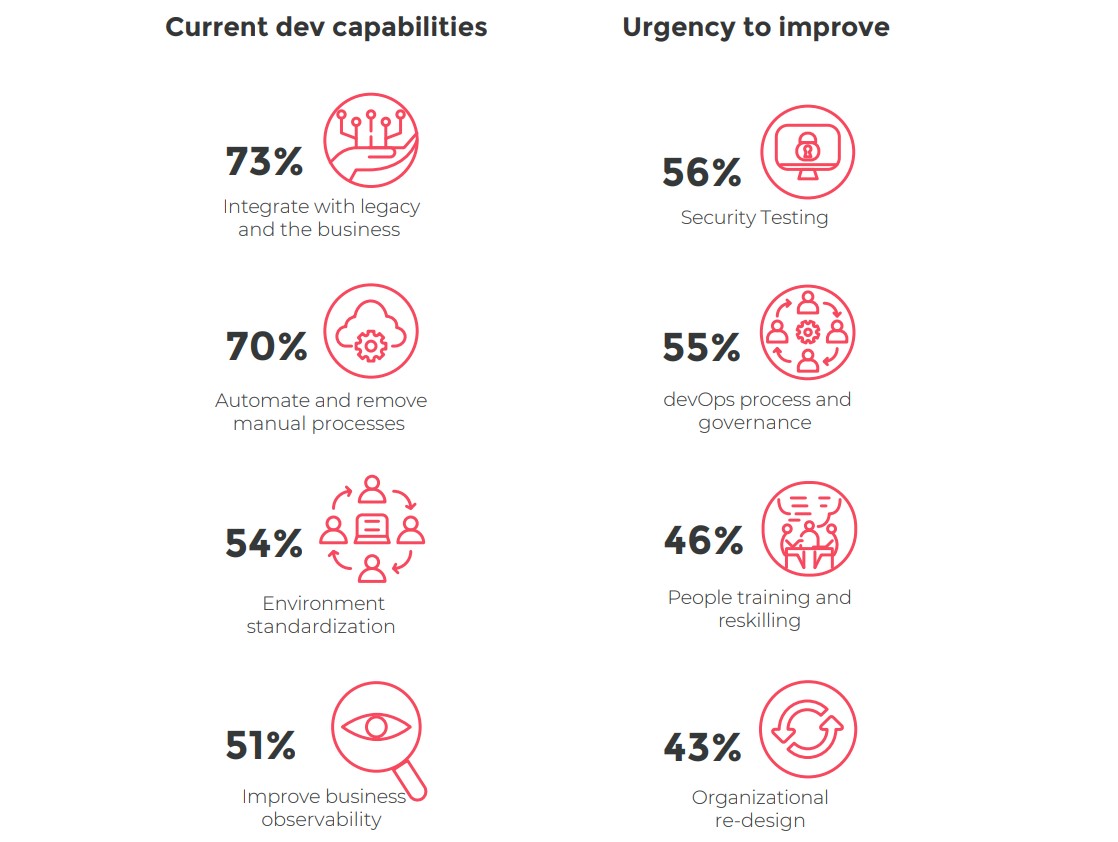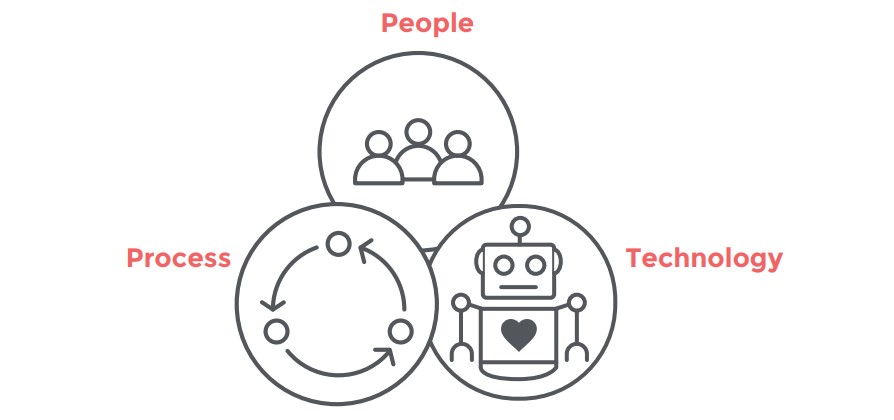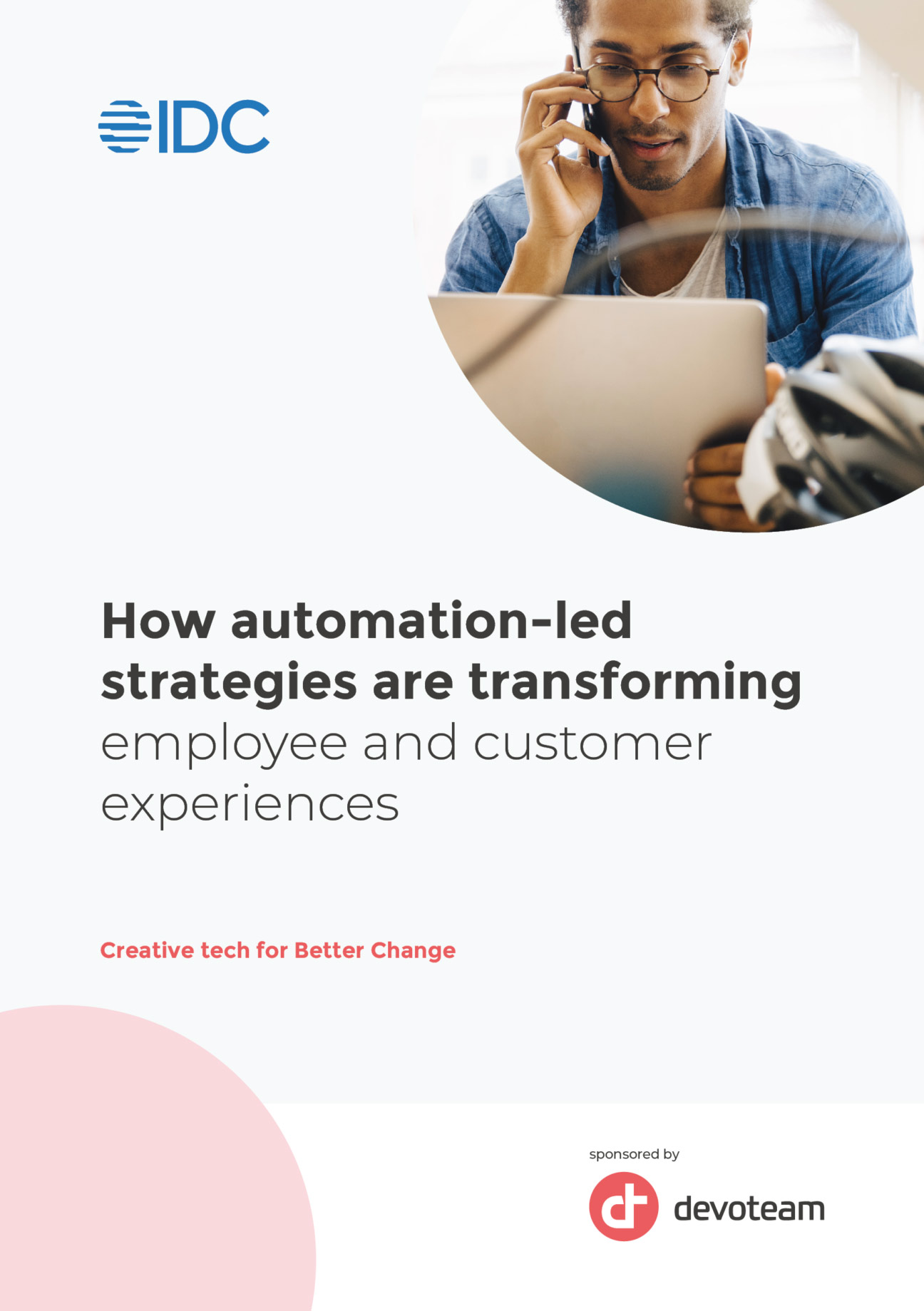Chapter 1: At a strategic level, automation can augment business functions and teams, boost compliance, and drive improved productivity.
Automation is far more than a tactical lever to optimize cost and time
Business automation can span across the entire IT landscape. It can help run lean IT, open up the possibility of running self-service apps, help identify single points of failure in systems, eliminate inconsistencies in data, and connect multiple systems to unite teams in different parts of the business. In summary, it can lay the foundations for the digital-native enterprise, supported by intelligently automated data, tasks, and processes.
These benefits are aligned with the challenges companies face
People are spending more and more time on repetitive, often mundane tasks, rather than on their core value-adding work. This applies to those in the business and IT, who are held back in their ability to deliver value because of repetitive manual tasks that are ideally suited to automation.
These benefits are aligned with the challenges companies face
IDC research shows that manual processes are the number-one bottleneck for European firms aiming to transform digitally. 71% of European organizations cite this as their biggest headache. Meanwhile, three-quarters of European firms struggle to integrate modernization initiatives with legacy systems and processes.
The challenges don’t stop there. IDC’s research also shows that 1 in 4 large European organizations still rely on ad-hoc, siloed software development and delivery capabilities. Data is rarely shared and used collaboratively because of the long-standing data silos, multiple systems of record and engagement, and inconsistent processes. So, they aren’t operating with agility and are far from optimized internally to extract the benefits they’re looking for.
At an operational level, the business doesn’t achieve its aims because users become frustrated by the repetitive manual workload and their inability to get access to real business insights and true cross-team collaboration.
At the same time, customers become frustrated by the slow responsiveness and poor service this causes. This can have far-reaching consequences, such as increased customer churn, reduced net promoter scores (NPS), and ultimately failure of the business if it isn’t rectified.
Business outcome-focused automation can mend fragmented and disintegrated processes – transforming experiences withing IT and business
Organizations need help moving to an agile culture There’s a clear disconnect between what organizations claim to be achieving internally today and where they really are.
IDC’s research in DevOps maturity found that although 80% of European organizations practice agile/DevOps methods, only 10% are truly optimized.
Organizations need help moving to an agile culture at scale because they still urgently need help improving business observability, security testing, and governance processes, as well as training, reskilling teams, and organizational redesign to optimize change.
A lot of these barriers are down to culture, which is very difficult to change from the inside-out without a pragmatic approach.
European Organizations Challenged to:
Organizations struggle to navigate the application complexities faced in their applcation modernization programs

Use-case 1: Adecco Group embraces cloud collaboration for business resilience
IDC View: Adecco began with an urgent need for cloud collaboration during the pandemic as the business moved to work from home. The automation of manual processes then emerged as a natural next step to transform adjacent outdated working practices that were disrupted by the remote working model.
IDC spoke with Julien Bryard, Adecco Group’s CTO based in Lyon, France, to understand how Adecco has responded over the past 18 months with automation-enabled solutions to boost resilience across the group.
Adecco Group is the parent company of global recruitment consultancy brand Adecco. Employing 30,000 employees worldwide, including 8,000 based across its major European markets of France and Switzerland (HQ), Adecco operates a number of brands in the workforce, talent, and technology sectors.
The Business Challenge
Like many organizations, following the pandemic-enforced lockdown, Adecco Group had to move to a work from home model effectively overnight. The organization had to react quickly to this new reality, ensuring that all 9,000 employees in France had laptops, Microsoft Teams availability for remote
collaboration, and business applications for productivity. Under normal circumstances, Adecco operates a high-touch working environment, with over 1,000 sites in France alone providing face to face client and candidate contact.
Another business challenge was to clean up and automate all repetitive tasks.
The Solution
Adecco introduced a new work from home strategy that includes contingencies for the long-term as the new normal working environment becomes clearer.
Collaboration via Microsoft Teams was critical to the project. In particular, the communications and marketing department were trained on Microsoft Teams Live Event for Adecco’s internal and external events. This was achieved rapidly, with implementation and training for 30 employees within the month. Before the crisis, only 30% of Adecco employees used Teams, and post-crisis it has scaled this to enable more than 90% of its workforce with Teams.
From the go-live in September 2020 to March 2021, Adecco ran approximately 200 Teams Live events with as many as 1,000 people on any event. This has been expanded since the beginning of 2021 to include the company’s big ‘kick off’ event from the top management.
Adecco engaged with Microsoft and Devoteam to provide the Microsoft cloud-based platform including Teams and Teams Live suites as well as implementation and training for the business.
Key Learnings
Platform product expertise critical
Adecco has its own IT services business, Modis. However, it needed specialist Microsoft platform skills fast, which meant it needed to look to an external partner for delivery. Devoteam is a Microsoft Gold Partner, which was considered essential for this project.
Place business before IT
Beyond that, the single most important factor was to select a technology provider that really understood Adecco’s business and the way it works. Bryard did not want another cookie cutter IT solution, which he sees as a significant pain point. Adecco prioritized business outcomes and focused on business value that the solution brought to its needs.
Language of the business critical
Adecco wanted a tailored offering, and important to this was Devoteam’s ability to adapt itself and its language from a technical IT solution to the language of the business and its needs. This proved to be critical to achieving adoption success, since nontechnical users in communications and marketing were trained to understand how the solution worked.
They are now able to customize the tool to their own needswithout the need for hands on support.
Customized service
Bryard considered this a customized service for Adecco’s needs to provide enough support for the teams, but without taking ownership away from the business. In this way, internal IT still retains the control and oversight of the system, but it can call on external support if required.
Next Steps
Adecco is now looking to make more of the Devoteam and Microsoft partnership in RPA in areas where lots of manual tasks are still being performed. Bryard says the company is looking at mid-office business activities such as call center services to help branches in different cities in fields like contract fulfilment and timesheets.

Chapter 2: Rethinking service delivery for
Business Automation – Unifying Customer and Employee
Experience
Three ways to rethink Business Automation success
1 – Technology and process should be the enabler
Elevating the conversation above the technical detail is key to understanding the real business drivers for automation-led change that impact positively on people’s working environment. This involves engaging with the business to understand where the manual pain points lie that are getting in the way of employees performing their tasks as effectively as possible. Whether, for instance, data is not easily available to be processed or analyzed, whether multiple systems are being used that involve significant amounts of information to be rekeyed or duplicated. Understanding how these negatively impact productivity and job satisfaction is key.
2 – Redesign automated process to put people first
Understanding the way that people, processes, and technology will interact in the new automated environment is key to success. This means bringing together technologies like low code, RPA, and intuitive workflows that provide contextualized information to the employee, enabling real-time access to information without the need to swivel between systems. To ensure adoption, organizations should create a multidisciplinary team from IT, business, and other user groups to be deeply involved in the change program. It also means creating an operational model, a governance structure to allow it to develop at the rhythm of the needs of users, and the technological innovations.
3 – Ensuring all roads lead to business outcomes
Create an automation culture that is obsessive about optimizing the workflow between teams and aligned to business outcome objectives. KPIs will differ from one implementation to another and depending on where the automation is intended. But outcomes should always refer to overall employee experience and/or customer experience benefits intended. These can be measured by employee and customer satisfaction (ESAT and CSAT), net promoter scores (NPS), and impact on top- and bottom-line financial performance.
Automation should unify people, processes, and technology with common outcome objectives
Improved Employee Experience, Via:
- Intuitive workflows
- Integration between systems
- Contextualized information
- Data-driven insights
- Single pane of glass for all apps
- Self-service apps
Improved Customer Experience, Via:
- Rapid and accurate response to queries
- Real-time performance
- Improved time to market
- Speed to results
- Seamless interaction and connectivity

Use-case 2: Automation delivering thousands of hours back to the business, improving employee satisfaction
IDC View: Automation has evolved at Leo Pharma from being seen as a cost and efficiency play, to one that has been highly successful, supporting broader ambitions around hiring and retaining the best talent and ensuring competitiveness in the market.
IDC spoke with Troels Ravn Baerentzen, Leo Pharma’s VP for data and analytics:
People are super happy that their manual and repetitive work is removed and they are no longer doing 110% of their jobs. They can now have an improved work-life balance. We thought automation would be seen as a threat, but it’s been seen as a real help and an enabler for helping us transform our business.
Leo Pharma is a 110-year-old pharma company, headquartered in Denmark, specializing in the R&D and manufacturing of drugs for dermatology and thrombosis, with presence in over 130 countries and 6,000 employees.
The Business Challenge
Like all pharma companies, Leo Pharma operates in a highly regulated space, and with that comes huge compliance processes to ensure it achieves laboratory, clinical, and manufacturing good practice (GxP). Operating in more than 100 countries and with as many partners and compliance processes requires many resources to, for example, make relevant R&D data available for doctors to check drug safety and ensure quality control checks of various processes. This involves a lot of repetitive manual data documentation and analysis on spreadsheets, which its highly skilled teams were spending thousands of hours working on — collecting, inputting, and accessing data across different systems. These are time-consuming tasks that distract its teams of skilled specialists from their core work which results in longer working days.
Related to this, Leo Pharma needs to ensure that it can compete for and retain the top talent and to be seen as modern company. Automation became part of its strategy to reduce manual processes and release employees to be more productive and efficient.
The Solution
Automation has been targeted at these complex data-led processes. Due to the lack of knowledge and skills internally in relation to automation, Leo Pharma sought an external partner to help it execute its ambitions.
Business Case
From a business case perspective, Leo Pharma sees automation as an efficiency tool, because it can deliver hours back to the business. This is the key metric by which it measures success. And it’s been very powerful so far. In 2020, it delivered 10,000 hours back to the business through the automation of about 25 processes. Baerentzen says the team in R&D are planning to deliver 30,000 hours to the business in 2021. Next year it expects to give back an impressive 60,000 hours.
Devoteams Role
Devoteams role is as a technical automation developer, advisor, and change manager. It now works as a key extension to the Leo Pharma team, with data engineers, automation developers, and a full stack project manager embedded in the business. Baerentzen expects Devoteam to “speak out loud”, challenge, “go beyond the code,” and this has been key to forming a successful relationship.
Devoteam also supports in the creation of Leo pharma’s pipeline of new bots, with good traction in clinical trial operation where it has many clinical studies with many data points and requirements for high data quality — not only for the data from the studies, but also for people monitoring the conduct of these studies, such as inspection-ready CVs and training files. Moreover, a clinical trial requires many different systems where data needs to be uploaded and this can potentially be automated.
In addition to the core processes being automated, Devoteam helps Leo Pharma run citizen automation initiatives, which are focused on simple processes like creating bots to upload files to SharePoint or Excel spreadsheets. One specific citizen automation was to automate the ordering of flowers — something that was performed 200 times a year.
Key Learnings
One of the key learnings is that automation outcomes extend beyond the hard metrics defined in the business case to include a number of “soft benefits” such as improved employee satisfaction, respecting what people are good at, and being able to learn from pitfalls and share best practice.
Baerentzen pointed out that the original plan was to “train our own employees” in automation and bot creation. But he changed his mind as the complexity of the processes and thereby the bots required specialized skills.
Leo Pharma has also shifted to explore expanding its use of automation across the business in a more measured way. It originally planned many pilots, including within functional teams such as HR and finance, but this needed to be anchored within the overall business strategy. So, it now focuses on more complex IT-led business processes and change management as the key to driving adoption and then scaling.
The focus of automation is now very much to augment rather than replace Leo Pharma’s skilled employees. This will be particularly valuable when Leo Pharma launches new products, since automation provides scalability without the need to invest in new resources, so the business can focus on efficiency. This learning has even expanded into considering that some bots may not provide many hours back to the business. But that is fine if they improve data quality or reduce timelines, because that in turn boosts productivity.
Chapter 3: Modern digital workplace demands Business Automation solutions
The modern digital workplace is distributed, agile, and highly automated
Productivity applications like Microsoft Office 365 and increasingly Google Workspace are now used by most organizations for the core business. These are inherently built with users in mind, cloudbased, available anywhere and on any device. However, integration with other business applications is increasingly needed to ensure that people can continue in the flow of work and not become sidetracked by opening and closing multiple applications and inputting and rekeying data between systems.
Automation is often built into applications to speed up tasks, but it is not often built between applications. What the modern digital workplace needs is an intuitive user experience that has seamless connectivity between applications that are chosen and used by the business.
New user experiences underpin an improved employee experience
Thought needs to be put into designing, building, and orchestrating the teams and technologies to make this happen. This means having multiple options at your disposal, such as knowing when to use RPA or APIs to integrate applications, whether to build collaboration and workflow tools, and business intelligence/analytics, to support teams across multiple domains, industries, and languages. Having a safe pair of hands to advise and guide on technical issues as well as deployment and adoption is critical.
Business users also need to be able to adapt their modern digital workplace to the speed of the business. This is where self-service and low-code development come into play, so that the business can react quickly regulatory or compliance changes, new product launches, or new customer marketing campaigns, for example. The ambition for self service and low code is to increasingly empower the user to execute automation and processes for themselves, and even consider building automation. But low code and other business user automation tools need to avoid turning into the “wild west of innovation” and require oversight from technical teams and IT to ensure they meet strict governance requirements.
Customer outcomes can make or break brands
Customer outcomes can make or break brands Improved customer outcomes are enabled by a service delivery mindset, because business automation isn’t just a technology solution. Services are essential across the transformation landscape to advise customers at the outset — to understand where the pain points lie and what options are available to them. Then it’s essential to have a safe pair of hands to design, integrate, and orchestrate automated solutions, as well as provide business-led change and training and encourage participation and adoption.
Services become the glue that can bind all the pieces of the puzzle together. Overcoming fragmented and disintegrated processes can empower teams to deliver great customer experience. Business automation can mend this and even result in new services that weren’t possible before.
Automation benefits
Tech-Led
Increase reliability
Improve Biz observability
Manage tech complexity
Business-led
Enhance customer and user experience
Boost business innovation
Accelerate response to business disruption
Use-case 3: Modern workplace enabled by cloud-based desktop productivity suite
IDC View: Randstad responded to complex user needs during the pandemic, rolling out Google Workspace across its newly distributed workforce. The automation of tasks could become the next frontier, using data and insights gathered from the integrated cloud applications.
IDC spoke with Peter Knaepkens, service and operations manager at Randstad:
A lesson we’re still learning is that we were very techorientated two years ago, because we came up with an app, but not a solution.
Randstad is a multinational recruitment and HR consultancy, headquartered in the Netherlands. It employs 29,000 people across its parent brands and numerous subsidiaries and is present in over 39 countries worldwide.
The Business Challenge
Randstad is transforming into an organization that aims to put humans before technology and to transform the way people and jobs connect. It is also investing to create innovations that are scalable, data-driven, and measurable. However, it still grapples with legacy systems and processes that have restricted its ability to move to a more agile cloud-based working environment, and upon which these innovations depend.
In early 2020, COVID-19 forced an urgent response from the business as overnight most of its staff were working from home and needed to be able to adapt their working hours to customer needs. People also wanted more flexibility to use their own devices.
The Solution
Modern Workplace
Knaepkens has been overseeing Randstad’s move from a Windows desktop environment to Google Workspace (formerly G-Suite). Devoteam G-cloud is the implementation and support partner for Randstad in Europe to establish best practice ahead of a global rollout. This involves switching from Windows PCs and laptops to Chromebooks, as well as supporting the implementation of a new communications platform that enables chat functionality across WhatsApp and other SoMe applications — “to use Google to the max.” Devoteam is also moving all Windows file shares to Google Drive.
Data and Analytics
Closely tied to the Google Workspace investment is a second track with Devoteam around data and analytics, creating a data warehouse and BigQuery analytics, and a self-service data platform for the organization, to achieve more real-time intelligence on business performance.
A trusted partner when things get tough
Randstad needed a partner to help advise and guide the business on its various technology tracks moving to Google. This included support evaluating the right technology, defining a business case, and then implementing. Knaepkens needed a provider that was responsive and skilled at project management and remediation.
Flexibility and adaptability also became important. The Chromebook rollout was interrupted by the pandemic. Stability issues also meant that the rollout was scaled down to a small user base while it was further tested before being launched into the wider corporate environment.
Key Learnings
“Don’t overwhelm people!” Knaepkens is adamant that a major program like this needs to include a period of adaptation and change, and a roadmap to get you where you intend to be. This is also the case for automation, which requires end-user involvement to make it a success.
Not everyone uses Google. Going all in on one solution needed challenging. wholesale transition meant that there were inevitable pushbacks from parts of the business where it didn’t support the end customer; for instance, in legal services, where practically all firms use Microsoft.
Automation has been trialed but still needs more investigation. RPA adoption and usage in the business has been less plain sailing. Knaepkens points out that some flows are now automated but the impact has been quite limited due other priorities from IT support, and within the platform itself.
Get business processes aligned and clearly documented was the biggest learning from the company’s automation story to date. Without this in place, Randstad found it impossible to scale automation usage.

